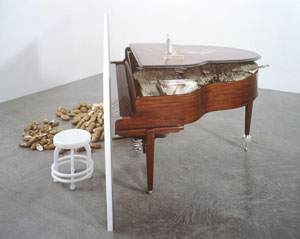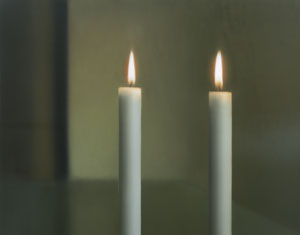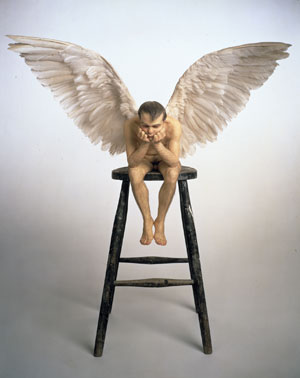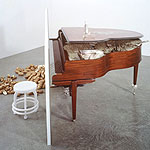The future is now in Dallas…and elsewhere on the globe. Fast Forward. Two other exhibitions in the last five years have used the same terminology as the current two-part extravaganza called Fast Forward at the Dallas Museum of Art.
Sponsored by the private Sammlung Goetz Collection in Munich, there was the cutting-edge exhibition in 2003 at ZKM (Center for Art and Media Karlsruhe) called Fast Forward: Media Art. And until April 9, Out of Time: A Contemporary View was on view at MoMA
in New York, an exhibition of contemporary art from the collection that
engaged with the following litany of terms — “Repeat, fast-forward,
rewind, pause, recycle, live, delay.” Also sharing the moniker “fast
forward” are a handful of poetry books, a smattering of photography
monographs, something on growing up as Carrie Fisher
in Hollywood and the confessions of a “porn writer.” The future, this
rendition of it anyway, has been around at least since the late ’80s.
One James Lardner captured the spirit of his moment, and apparently ours too, when he published Fast Forward: Hollywood, the Japanese, and the Onslaught of the VCR in 1987.
Who knew Hegel’s Zeitgeist
could cast a penumbra across two decades (1987-2007)? We are by now
well accustomed to the fact that there’s really no “geist” behind
“zeit.” God is no longer the motor of time. Technology is, and has been
for a while, the guiding force behind our cultural formation and
change. So, given the rapid pace of things, it seems somewhat
counterintuitive that we might be living in the same futurity of 20
years ago.
Thankfully we are not.
The name may be the same as Mr. Lardner’s 20-year-old book, but the goods in Fast Forward: Contemporary Collections for the Dallas Museum of Art are totally our own — and firmly of the 21st century. The future is really now in Dallas.
Fast Forward celebrates a giant bequest made in 2005 by three
powerful forces of art collecting in Dallas: the Hoffman, Rachofsky and
Rose families. Curated by María de Corral,
the exhibition offers a preview of others to come, as most of the
bequest still sits silently, hidden in coffer-like warehouses. The
three collectors have given more than 900 objects to the museum. And
this is truly a project of things-to-come: the three families have
donated future acquisitions as well.
For those of us comfortable with nonlinear juxtapositions, the
organization of the exhibition will be welcoming and familiar. There
are roughly 15 galleries of mixed-media work, the majority of which is
painting. Objects are grouped according to themes: ab-ex formalism; Cy
Twombly’s doodles and backside-frontside paintings; the painterly lines
and neo-geo work of Frank Stella, Brice Marden, Agnes Martin, Robert Mangold and Ellsworth Kelly; two side rooms for videos by Bruce Conner and Ant Farm, among others; a Gerhard Richter room; a Sigmar Polke room; a Robert Gober-Guillermo Kuitca–Doris Salcedo trifecta of surrealism, followed by the Ron Mueck–Tony Cragg
duet of surrealism, intermingled with Rachel Whiteread, Lucian Freud
and Francis Bacon on the walls; Matthew Barney and Cindy Sherman
coupled with Tony Oursler and Martin Kippenberger; a stand-out Doug Aitken three-single-channel video sculpture; Chris Burden; paintings and objects by Marlene Dumas, Mona Hatoum, Janine Antoni, Kiki Smith, Jim Hodges, Felix Gonzalez-Torres, Tom Friedman, Elizabeth Peyton, Trenton Doyle Hancock…and
many others. The list is long but the show is not exhausting. It is an
exhibition that has brought the international “new” to our doorstep. It
tells a story of “pluralism,” to use a ’70s term. For the antiquarians
in the crowd, you’ll just have to learn to love the loss of context.
There are no uniting themes — no historical consciousness — other than
a welcomed and shared mania for collecting high art.
The show is divided into three phases. Phase One showed from February
through April 2007 in the Barrel Vault; the Hanley, Lamont, Rachofsky
and Stoffel Galleries; and the Sculpture Garden. Phase Two — which
featured films, media works, photography and painting — showed from
December 2006 through April 2007 in the FINA Foundation Gallery,
Concourse, and Orientation Theater. And Phase Three continues until May
20, 2007, in the J.E.R. Chilton Galleries and the two Focus Galleries.
The meandering and unfolding nature of the show is testament to the
scale and variety of the donation.
In the first part of the show back in February, three stellar (and I mean amazing!) works by Louise Bourgeois
beckoned viewers to a new world on view under the central looming
cavern of the Barrel Vault. Aptly, each was donated by one of the three
family-forces. Deedie and Rusty Rose’s Untitled (2002), a column of stacked cloth bricks, reads something like a soft totem. It is reminiscent of the sculptural zips by Barnett Newman and an ersatz zipper potentially fabricated Claes Oldenburg. To the right stood Bourgeois’ Cell
(1993) from the Rachofsky collection, a room-scaled cage with wax hands
embracing at the center. To the left was the Hoffman family’s tumescent
Torso (1996), the archetypal female distilled in fuzzy towels
with feminist brio: she has no legs, arms or head — just large breasts
and engorged labia. These were followed by Robert Smithson’s Mirrors and Shelly Sand (1969-70), Bruce Nauman’s Untitled work in fiberglass and polyester resin mold (1965) and his Perfect Door/Perfect Odor/Perfect Rodo in fluorescent lights (1973), and a bevy of Arte Povera works by Mario Merz, Jannis Kounellis, Alighiero Boetti and Giulio Paolini.

Mario Merz...(Prefistoric Wind from the Mountains)...Vento Prehistorico dalle Montagne...1967...Mixed media on canvas, neon tubes, and brushwood...157 1/2 x 94 x 39 3/8 inches
I should make clear that works exhibited in Fast Forward
also come from the DMA’s standing collection and other donors. The
third portion of the exhibition, located in the Chilton and two Focus
Galleries closer to the entrance, features paintings from the latest
rejuvenation of the medium in the last decade. Here one finds Mamma Andersson’s Gone for Good (2006), a painting of a smoke-filled den with a burning couch, which was acquired from the Rachofsky Collection in part by an auction fund. Also hanging is Luc Tuymans’ Courtesy
(2005), a pearly gray painting of the canopy of a princess bed, the
promised gift of Gayle and Paul Stoffel. One gathers from the other
names involved — the Stoffels, Catherine and Will Rose, Mr. and Mrs.
Bryant M. Hanley Jr., Arlene and John Dayton, et al. — that the DMA has
been the recipient of generous benefaction for many years now.
The exhibition trumpets the glory of the DMA’s strengths: modern and,
even more so, contemporary art. The anemic van Gogh exhibition has come
and gone, and the similarly jejune Matisse show lumbers on in the back
galleries usually devoted to contemporary art. But the work of Fast Forward
is here to stay. In so many ways, the exhibition distills the identity
of the city. It is flamboyant in performance and appearance. The work
is about a splashy event —three enormously rich people doing the shared
good deed of giving art to the public. We have the objects, diverse in
media and provocative in form. Now all we need to do is to match it
with a rich and kaleidoscopic culture of art — including local and
international artists, writers and publications. We know how to
consume, but can we produce?
Images courtesy The Dallas Museum of Art
Charissa N. Terranova is an Associate Professor at SMU and a Contributing Editor to Glasstire.









